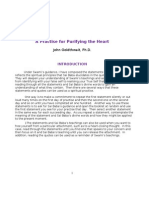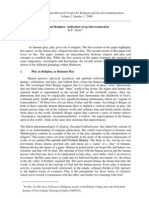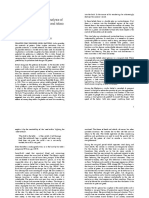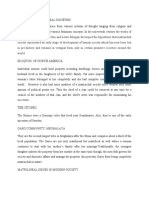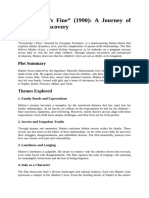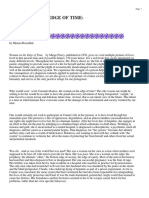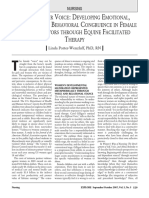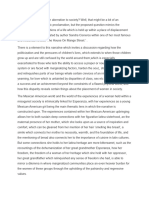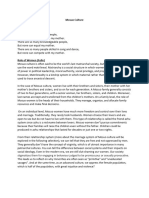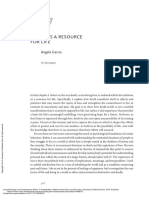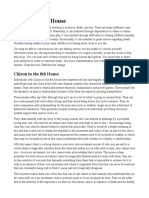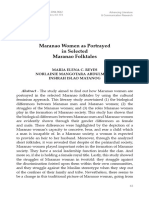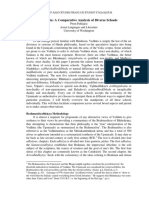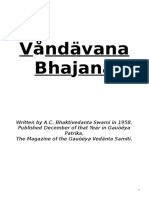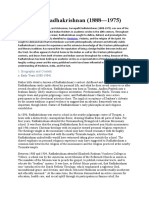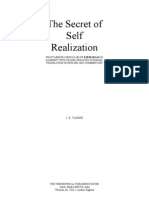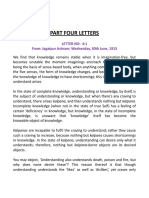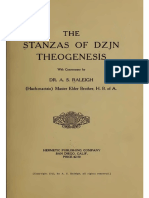The Complex Paradox of Maya
The Complex Paradox of Maya
Uploaded by
Nikhil ChauhanCopyright:
Available Formats
The Complex Paradox of Maya
The Complex Paradox of Maya
Uploaded by
Nikhil ChauhanCopyright
Available Formats
Share this document
Did you find this document useful?
Is this content inappropriate?
Copyright:
Available Formats
The Complex Paradox of Maya
The Complex Paradox of Maya
Uploaded by
Nikhil ChauhanCopyright:
Available Formats
The Complex Paradox of Maya: Unraveling Bonds in Aging for Men and Women in Mangaldihi
Introduction
In the quaint rural community of Mangaldihi, both men and women confront a profound and
intricate problem in the process of aging—the need to loosen tightly bound connections, termed
"maya," that encompass affection, attachment, and love for family, possessions, and the entire lived
experience. Unlike the common notion of maya as "illusion," in Mangaldihi, it represents an
emotionally charged and deeply problematic aspect of human existence. This essay delves into the
multifaceted dimensions of maya as experienced by men and women in Mangaldihi and explores its
impact on their aging journey.
1. Understanding Maya: The All-Encompassing Concept
Maya, a concept found in all Indian languages, takes on unique significance in Mangaldihi. Rather
than being seen as an illusory world, maya embodies emotional ties, bonding individuals to their
family members, belongings, and cherished surroundings. The villagers consider maya as one of the
chief evils alongside anger, greed, and jealousy. It intertwines with various aspects of life, resulting in
complex relationships and a paradoxical experience of aging.
2. Aging as Loosening Bonds: A Fragile Yet Compelling Time
In Mangaldihi, aging is not solely about maintaining family relations; it is about loosening the ever-
tightening bonds as one progresses through life. As the number of kin increases with age, so does
the intensity of emotional connections. Children, grandchildren, and affines further intensify maya,
making aging a time of both fragility and compelling emotions. Individuals find themselves
increasingly attached to people, possessions, and the land that forms their identities.
3. Maya in Late Life: Heightened Intensity and Impending Separation
As villagers approach the later stages of life, the intensity of maya surges. The realization of
impending separations and losses amplifies emotional connections to loved ones and cherished
belongings. This heightened awareness makes late life a delicate interplay between fragile
relationships and compelling emotions. Aging becomes a paradoxical time when relations are most
delicate, yet the pulls of maya are at their strongest.
4. Women's Unique Journey: Unmaking and Remaking Personhood
In the context of maya and aging, women experience distinctive challenges compared to men. They
undergo the unmaking and remaking of their personhood not only in aging and dying but also
through significant life events such as marriage and widowhood. These transitions further entangle
their identities with people and places, making it arduous to loosen the bonds of maya. Women's
experiences highlight the complexity of balancing maya while preparing for the later stages of life.
5. The Dangers of Excessive Maya: Lingering Ghosts and Painful Departures
Excessive maya poses profound consequences for those in late life. It can lead to individuals clinging
onto life, even in the face of frailty and suffering, resulting in a slow and painful process of dying. The
fear of leaving loved ones and cherished belongings behind hampers the natural course of death.
Villagers believe that those passing away with unresolved maya may become lingering ghosts, bound
to their former households and unable to find peace after death.
6. The Quest for Mukti: Liberating the Soul from Maya's Chains
The ultimate pursuit for individuals is mukti or liberation, entailing freedom from maya's binding ties.
Achieving mukti means release from lingering as a ghost and attaining peace after death. However,
this state of absolute freedom from all ties is considered elusive and challenging to attain. The
balance between love and attachment to the world and the yearning for peace and liberation
becomes the focal point of individuals' aging journey.
Conclusion
The concept of maya pervades every aspect of aging for men and women in Mangaldihi, presenting a
profound paradox. The loosening of tightly woven bonds becomes a central concern, reflecting the
fragile nature of relationships and the compelling emotions that arise with age. Excessive maya poses
risks not only in late life but also after death, potentially leaving individuals as lingering ghosts bound
to their past. The quest for mukti, or liberation from the bindings of maya, remains an elusive
endeavor, urging individuals to grapple with the delicate balance between affection for their world
and the desire for eternal peace and release.
You might also like
- Spiritual and Cultural Implications of The BorderlineDocument11 pagesSpiritual and Cultural Implications of The BorderlineAnonymous nVw5x7m100% (2)
- Goldthwait Purifying The Heart Practise LayoutDocument20 pagesGoldthwait Purifying The Heart Practise LayoutRicardo Quintero100% (3)
- Richard Rudd - The Issue ArticlesDocument12 pagesRichard Rudd - The Issue ArticlesJay Rose100% (7)
- K.P. Aleaz - Play and ReligionDocument12 pagesK.P. Aleaz - Play and ReligionSoftbrain100% (8)
- Controlled Women & Constipated Men: Uncomfortably DisquietingFrom EverandControlled Women & Constipated Men: Uncomfortably DisquietingRating: 5 out of 5 stars5/5 (1)
- Gergen, K. - A Collage of Postmodern Life (From 'The Saturated Self') PDFDocument16 pagesGergen, K. - A Collage of Postmodern Life (From 'The Saturated Self') PDFWhatever Forever100% (3)
- Reconciling Values of Attachment and Renunciation in Late LifeDocument2 pagesReconciling Values of Attachment and Renunciation in Late LifeNikhil ChauhanNo ratings yet
- DOUGLAS, Mary. Purity and Danger - An Analysis of The Concepts of Pollution and Taboo (1966) PDFDocument12 pagesDOUGLAS, Mary. Purity and Danger - An Analysis of The Concepts of Pollution and Taboo (1966) PDFBIAGIOPECORELLINo ratings yet
- Cry, The Peacock: Portrayal of Feminine And: Masculine DoctrinesDocument3 pagesCry, The Peacock: Portrayal of Feminine And: Masculine DoctrinesIJELS Research JournalNo ratings yet
- Exploring the Spiritual Hazards and Unveiling Secrets of Prostitutes: An In-Depth InvestigationFrom EverandExploring the Spiritual Hazards and Unveiling Secrets of Prostitutes: An In-Depth InvestigationNo ratings yet
- Woven Lives Sisterhood and Feminism 1Document32 pagesWoven Lives Sisterhood and Feminism 1Rikardo SihombingNo ratings yet
- Suárez-Krabbe, J. (2012) - Identity and The Preservation of Being. Social Identities, 18 (3), 335-353.Document20 pagesSuárez-Krabbe, J. (2012) - Identity and The Preservation of Being. Social Identities, 18 (3), 335-353.Thaysa AndréiaNo ratings yet
- The Loneliness Epidemic - How to Build Meaningful Connections in a Disconnected WorldFrom EverandThe Loneliness Epidemic - How to Build Meaningful Connections in a Disconnected WorldNo ratings yet
- Book Review On Zygmunt Baumans Liquid LoDocument6 pagesBook Review On Zygmunt Baumans Liquid LoAhmedNo ratings yet
- Embrase or Erase: Sketching the Lines of Lasting Bonds: Smart Guide for People Who Are Tired of Drama and Want to Build a Healthy Relationship Based on Trust, Communication and Emotional ConnectionFrom EverandEmbrase or Erase: Sketching the Lines of Lasting Bonds: Smart Guide for People Who Are Tired of Drama and Want to Build a Healthy Relationship Based on Trust, Communication and Emotional ConnectionNo ratings yet
- Short StoriesDocument9 pagesShort StoriesMehwish AfzalNo ratings yet
- 08 - Chapter 3Document45 pages08 - Chapter 3Rajnikant CreationNo ratings yet
- History of Matrilineal SocietiesDocument3 pagesHistory of Matrilineal SocietiesShreyaNo ratings yet
- The Diversity of Feminist ThinkingDocument4 pagesThe Diversity of Feminist ThinkingtiyaaNo ratings yet
- Porfolio - Argumentative EssayDocument5 pagesPorfolio - Argumentative Essayapi-546740815No ratings yet
- The Householder: A Peek into the Changing Role of Women in IndiaFrom EverandThe Householder: A Peek into the Changing Role of Women in IndiaNo ratings yet
- book sumaaryDocument12 pagesbook sumaaryrashidhussain76340No ratings yet
- 1980-Bonds of Love-BenjaminDocument32 pages1980-Bonds of Love-BenjaminNessa100% (3)
- Feminine Masculine Balance: A Paradigm Shift for a Peaceful and Abundant SocietyFrom EverandFeminine Masculine Balance: A Paradigm Shift for a Peaceful and Abundant SocietyRating: 2 out of 5 stars2/5 (1)
- English Holiday Homwork Project File 11th ClassDocument13 pagesEnglish Holiday Homwork Project File 11th Classarmaansaini240908No ratings yet
- Summary of Women Rowing North by Mary Pipher:Navigating Life’s Currents and Flourishing as We Age: A Comprehensive SummaryFrom EverandSummary of Women Rowing North by Mary Pipher:Navigating Life’s Currents and Flourishing as We Age: A Comprehensive SummaryNo ratings yet
- MisogynyDocument4 pagesMisogynyRamon Dos Santos Souza100% (1)
- DivyansheeVats LATWFINALDocument5 pagesDivyansheeVats LATWFINALDivyanshee VatsNo ratings yet
- A Case Study of The Effects of Superstit PDFDocument10 pagesA Case Study of The Effects of Superstit PDFGail BermudezNo ratings yet
- When Love Comes to Light: Bringing Wisdom from the Bhagavad Gita to Modern LifeFrom EverandWhen Love Comes to Light: Bringing Wisdom from the Bhagavad Gita to Modern LifeNo ratings yet
- Woman On The Edge of Time: ObservationsDocument5 pagesWoman On The Edge of Time: ObservationsBenita Alves de MeloNo ratings yet
- Anda Sou Uma Garota - LepaniDocument12 pagesAnda Sou Uma Garota - LepaniMuseu da MONo ratings yet
- Ann Ulanov - Review Leaving My Fathers House A Journey To Conscious Femininity by Marion WoodmanDocument4 pagesAnn Ulanov - Review Leaving My Fathers House A Journey To Conscious Femininity by Marion WoodmanNorahNo ratings yet
- The Vital Spark: Reclaim Your Outlaw Energies and Find Your Feminine FireFrom EverandThe Vital Spark: Reclaim Your Outlaw Energies and Find Your Feminine FireNo ratings yet
- 2007-Porter-Wenzlaff, Linda-Developing Emotional, Cognitive, and Behavioral Congruence in Female Abuse SurvivorsDocument6 pages2007-Porter-Wenzlaff, Linda-Developing Emotional, Cognitive, and Behavioral Congruence in Female Abuse SurvivorsHarrison LópezNo ratings yet
- HOUSE ON MANGO STREET EssayDocument4 pagesHOUSE ON MANGO STREET EssaywebshrineNo ratings yet
- Mosuo Culture BlogDocument3 pagesMosuo Culture Blogp57snv5w6bNo ratings yet
- Understanding The Real-Life Application of The Lessons in Different Issues of Morality: An Analysis On Ethical PrincipleDocument8 pagesUnderstanding The Real-Life Application of The Lessons in Different Issues of Morality: An Analysis On Ethical PrincipleapuradokayceeNo ratings yet
- KWML NotesDocument2 pagesKWML NotesjuthicogakNo ratings yet
- Burning Femininity: Gigliola ZanettiDocument16 pagesBurning Femininity: Gigliola ZanettiKali ErikaNo ratings yet
- Grossly UnproductiveDocument3 pagesGrossly UnproductiveLinda StupartNo ratings yet
- IDEOLOGYDocument13 pagesIDEOLOGYAlgene TagumpayNo ratings yet
- Beyond Gender: Understanding the Essence of Womanhood and ManhoodFrom EverandBeyond Gender: Understanding the Essence of Womanhood and ManhoodNo ratings yet
- Impossible Dream Thought Paper - DRAFTDocument2 pagesImpossible Dream Thought Paper - DRAFTdengracia2128No ratings yet
- Death As A Resource For LifeDocument20 pagesDeath As A Resource For LifeJCNo ratings yet
- EdibleDocument22 pagesEdibleannanguyen84No ratings yet
- Chiron in 8thDocument2 pagesChiron in 8thaNo ratings yet
- ALCR Vol 1 283 29Document19 pagesALCR Vol 1 283 29Janida AlamadaNo ratings yet
- SLEM Module 8 WK 8 Death - File - StudentDocument8 pagesSLEM Module 8 WK 8 Death - File - StudentLilowsNo ratings yet
- Polyamory EssayDocument6 pagesPolyamory Essayapi-241353144No ratings yet
- Hynes Characteristics EssayDocument3 pagesHynes Characteristics EssayHaven Graper100% (1)
- Vedanta ExplainedDocument411 pagesVedanta ExplainedSivasonNo ratings yet
- Sri Sai Amrit Vani (Explained in English)Document31 pagesSri Sai Amrit Vani (Explained in English)Shailen BhattNo ratings yet
- Colloquium03 DiffVedantas PDFDocument17 pagesColloquium03 DiffVedantas PDFDilip LoundoNo ratings yet
- Birth of Tragedy.5Document25 pagesBirth of Tragedy.5Rich ReesNo ratings yet
- Aindra - The Heart of Transcendental Book Distribution - B. CHPT 1-4, Appendix, GlossDocument256 pagesAindra - The Heart of Transcendental Book Distribution - B. CHPT 1-4, Appendix, GlossDina-Anukampana DasNo ratings yet
- Ethos of Vedanta in ManagementDocument2 pagesEthos of Vedanta in ManagementHema MehtaNo ratings yet
- Vrndavana Bhajana - by Srila PrabhupadaDocument9 pagesVrndavana Bhajana - by Srila PrabhupadaNeerajNo ratings yet
- Art of Spiritual Life - SyamaraniDocument170 pagesArt of Spiritual Life - SyamaraniJulio MedaNo ratings yet
- Oba 5 BKSDocument6 pagesOba 5 BKSNAMRTHA RATHNAKUMARNo ratings yet
- Eat LiberationDocument40 pagesEat LiberationJohn Paul ZahodyNo ratings yet
- Mandukya Karika (PDFDrive) PDFDocument35 pagesMandukya Karika (PDFDrive) PDFArvind AnvekarNo ratings yet
- Waves of GangaDocument141 pagesWaves of GangakartikscribdNo ratings yet
- The Rig Veda A Study of Sacred Speech SaDocument23 pagesThe Rig Veda A Study of Sacred Speech SaKuba KalicNo ratings yet
- Sarvepalli Radhakrishnan (1888-1975) : 1. Biography and ContextDocument19 pagesSarvepalli Radhakrishnan (1888-1975) : 1. Biography and Contextpit karwayuNo ratings yet
- SONGBOOKMEDICINAMANTRADocument137 pagesSONGBOOKMEDICINAMANTRAedwin almecigaNo ratings yet
- IndiannessDocument39 pagesIndiannessmanmalNo ratings yet
- Quintessence of Brahmasutra Shree Bhashya Mahamahopadhyaya Iranganti Rangacharya 2002 OCRDocument424 pagesQuintessence of Brahmasutra Shree Bhashya Mahamahopadhyaya Iranganti Rangacharya 2002 OCRAnsh RathodNo ratings yet
- The Secret of Self RealizationDocument63 pagesThe Secret of Self RealizationAspirant100% (8)
- Patravali Part Four (14883)Document109 pagesPatravali Part Four (14883)saumyaNo ratings yet
- Mind of Nama PrabhuDocument7 pagesMind of Nama PrabhuSantoshNo ratings yet
- Rudolf Steiner - The Alphabet GA 209Document15 pagesRudolf Steiner - The Alphabet GA 209Raul Popescu100% (1)
- Sri Guru Tattva VijnanaDocument14 pagesSri Guru Tattva Vijnanaharibhakta100% (1)
- Rudra Gita (Bhagavata Purana, 4.24.16-79) - EngDocument15 pagesRudra Gita (Bhagavata Purana, 4.24.16-79) - EngJose LuisNo ratings yet
- Concept of Objective PsycheDocument11 pagesConcept of Objective PsychesauloNo ratings yet
- Thomas Merton: Soul of The Age by Kathleen Noone Deignan, CNDDocument24 pagesThomas Merton: Soul of The Age by Kathleen Noone Deignan, CNDKathleen Deignan100% (2)
- 1915 Raleigh Stanzas of DZJN TheogenesisDocument191 pages1915 Raleigh Stanzas of DZJN TheogenesisMichael MorettiNo ratings yet
- Doc101 222 p2 TextDocument69 pagesDoc101 222 p2 TextjhapraveshNo ratings yet

